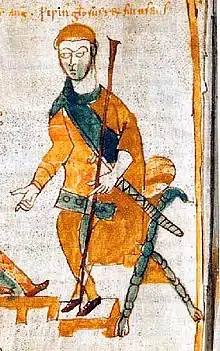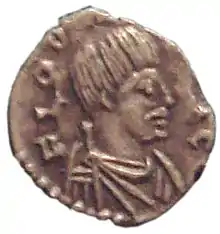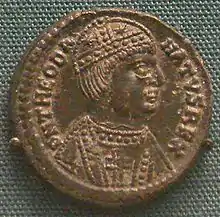Pepin of Italy
Pepin or Pippin (or Pepin Carloman, Pepinno, April 777[1] – 8 July 810), born Carloman, was the son of Charlemagne and King of the Lombards (781–810) under the authority of his father.
| Pepin | |
|---|---|
 Pepin depicted on a 10th century copy of a manuscript originally made in 829–836. | |
| King of the Lombards | |
| Coronation | 781 |
| Predecessor | Charlemagne |
| Successor | Charlemagne and Bernard of Italy |
| Born | Carloman April 777 |
| Died | 8 July 810 (aged 33) |
| Issue more... | |
| Father | Charlemagne |
| Mother | Hildegard |
| Carolingian dynasty |
|---|
 |
Pepin was the second son of Charlemagne by his then-wife Hildegard.[2] He was born Carloman, but was rechristened with the royal name Pepin (also the name of his older half-brother Pepin the Hunchback, and his grandfather Pepin the Short) when he was a young child. He was made "king of Italy"[3] after his father's conquest of the Lombards, in 781, and crowned by Pope Hadrian I with the Iron Crown of Lombardy.
He was active as ruler of Lombardy and worked to expand the Frankish empire. In 791, he marched a Lombard army into the Drava valley and ravaged Pannonia, while his father marched along the Danube into Avar territory. Charlemagne left the campaigning to deal with a Saxon revolt in 792. Pepin and Duke Eric of Friuli continued, however, to assault the Avars' ring-shaped strongholds. The great Ring of the Avars, their capital fortress, was taken twice. The booty was sent to Charlemagne in Aachen and redistributed to all his followers and even to foreign rulers, including King Offa of Mercia. A celebratory poem, De Pippini regis Victoria Avarica, was composed after Pepin forced the Avar khagan to submit in 796.[4] This poem was composed at Verona, Pepin's capital after 799 and the centre of Carolingian Renaissance literature in Italy. The Versus de Verona (c. 800), an urban encomium of the city, likewise praises king Pepin.[5] The "Codex Gothanus" History of the Lombards hails Pepin's campaign against Benevento and his liberation of Corsica "from the oppression of the Moors."[6]
His activities included a long, but unsuccessful siege of Venice in 810. The siege lasted six months and Pepin's army was ravaged by the diseases of the local swamps and was forced to withdraw. A few months later Pepin died, on 8 July 810.[7]
Family
The issue of Pepin's relationships is not entirely clear. A litany of Liber confrater augiensis[8] attributes to him as his wife a certain Chrotais (or Ruadheid), married shortly before 796,.[9] However, the Vita Hludowici written by Thégan around 840 says that King Bernard of Italy was born of a concubine (ex concubina natus), an affirmation reinforced by a litany of St. Gallen placing Bernard in a list of Carolingians of illegitimate birth.[10]
We do not know the origin of Chrotais but her name, that of Bernard of Italy and the fact that Adalard de Corbie and his half-brother Wala are then the protectors of Bernard of Italy suggests a close relationship between Chrotais and these. This hypothesis is reinforced by the fact that the first names of Bernard, Gundrada and Theodrada are found in the brothers and sisters of Wala and Adalard. Only, it is chronologically improbable that Chrotais is daughter of Wala, impossible that it is daughter of a brother or sister of Wala, who were too young, and the Vita Adalhardiis formal about the fact that Bernard had only five children. It remains as an explanation that the wife of Pepin d'Italie is a grand-niece of his namesake, the third wife of Charles Martel.[11]
Pepin had one son and five daughters (they were: Adelaide, married Lambert I of Nantes; Atala; Gundrada; Bertha; and Tetrada), all of whom but the eldest were born between 800 and Pepin's death. All except Adelaide and Tetrada died before their grandfather's death in 814. Tetrada married Adelaide's stepson, Lambert II of Nantes. Pepin's son was Bernard. Pepin was expected to inherit a third of his father's empire, but he predeceased him. The Lombard crown passed on to his illegitimate son Bernard, but the empire went to Pepin's younger brother, Louis the Pious.
Notes
- Karl Ferdinand Werner, "Die Nachkommen Karls des Großen bis um das Jahr 1000 (1.-8. Generation)", Karl der Große 4 (1967): 403-483
- Kingship and Royal Government, Janet L. Nelson, The New Cambridge Medieval History, Vol. 2, ed. Rosamond McKitterick, (Cambridge University Press, 1991), 400.
- However exaggerated the title "king of Italy" may seem, it was the one used by his subjects: ..."[Charlemagne] transferred all the kingdom of Italy to his great and glorious son lord Pippin, the great king"... (Historia Langobardorum codicis Gothani, in Monumenta Germaniae Historica, Scriptores rerum Langobardicarum et Italicarum saec. VI-IX, p.11.)
- Peter Godman (1985), Latin Poetry of the Carolingian Renaissance (Norman: University of Oklahoma Press), 186–191.
- Godman, 180–187.
- Monumenta Germaniae Historica, Scriptores rerum Langobardicarum et Italicarum saec. VI-IX, p. 11.
- Royal Frankish Annals
- This litany, extracted from the Monumenta Germaniae Historica , gives the list of Carolingian kings and queens from Charles Martel to King Bernard of Italy (Settipani 1993, pp. 168–169, 211).
- A letter from Alcuin dating from 796 describes him as a young groom.
- (Settipani 1993, p. 211, note 142).
- Settipani 1993 , p. 212.
Pepin Carloman Born: April 777 Died: 8 July 810 | ||
| Regnal titles | ||
|---|---|---|
| Preceded by Charlemagne |
King of the Lombards 15 April 781 – 8 July 810 with Charlemagne (774–814) |
Succeeded by Charlemagne Bernard |


